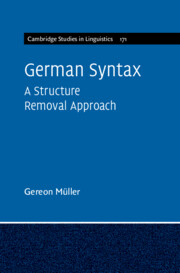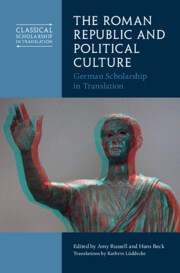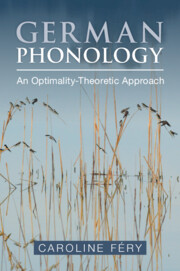Refine search
Actions for selected content:
97 results
1 - German-Soviet Relations and Military Collaboration in the Inter-war Period
- from Part I - Conceptions of War
-
-
- Book:
- The Cambridge Companion to the Nazi-Soviet War
- Published online:
- 13 November 2025
- Print publication:
- 20 November 2025, pp 9-26
-
- Chapter
- Export citation
15 - Symphonic Music in the Nineteenth-Century Czech Lands
- from Part II - The “Long” Nineteenth Century
-
-
- Book:
- A History of Music in the Czech Lands
- Published online:
- 21 October 2025
- Print publication:
- 16 October 2025, pp 212-225
-
- Chapter
- Export citation
Effects of Sociophonetic Variability on L2 Vocabulary Learning
-
- Journal:
- Studies in Second Language Acquisition / Volume 47 / Issue 4 / September 2025
- Published online by Cambridge University Press:
- 26 August 2025, pp. 1071-1095
- Print publication:
- September 2025
-
- Article
- Export citation
What is German ‘Angst’ (fear/anxiety)? A corpus approach based on frame analysis
-
- Journal:
- Language and Cognition / Volume 17 / 2025
- Published online by Cambridge University Press:
- 26 August 2025, e67
-
- Article
-
- You have access
- Open access
- HTML
- Export citation
The perception of post-focal prominence is (also) a matter of linguistic structure
-
- Journal:
- Journal of the International Phonetic Association , First View
- Published online by Cambridge University Press:
- 20 August 2025, pp. 1-22
-
- Article
-
- You have access
- Open access
- HTML
- Export citation
14 - Reflections on Coordination in Word-Formation
- from Part III - Syntactic Questions
-
- Book:
- Reflections on English Word-Formation
- Published online:
- 03 October 2025
- Print publication:
- 07 August 2025, pp 110-116
-
- Chapter
- Export citation
Temporal relationships between speech and hand gestures in the vicinity of potential turn boundaries in German and Swedish conversation
-
- Journal:
- Language and Cognition / Volume 17 / 2025
- Published online by Cambridge University Press:
- 21 July 2025, e57
-
- Article
-
- You have access
- Open access
- HTML
- Export citation
Standardizing Americanization: District Consolidation and the Making of the German Language Program in Milwaukee’s Public Schools, 1846-1918
-
- Journal:
- History of Education Quarterly / Volume 65 / Issue 3 / August 2025
- Published online by Cambridge University Press:
- 13 June 2025, pp. 312-336
- Print publication:
- August 2025
-
- Article
- Export citation
Aspectual Verbs in German: A Diachronic View
-
- Journal:
- Journal of Germanic Linguistics / Volume 37 / Issue 2 / June 2025
- Published online by Cambridge University Press:
- 09 June 2025, pp. 163-189
-
- Article
- Export citation
1 - Previous Research on Language Readability
-
- Book:
- Multilingual Environmental Communications
- Published online:
- 16 May 2025
- Print publication:
- 05 June 2025, pp 1-22
-
- Chapter
- Export citation
Cross-cultural validation of the integrated palliative outcome scale for neurological patients (IPOS-Neuro S8) in multiple sclerosis patients
-
- Journal:
- Palliative & Supportive Care / Volume 23 / 2025
- Published online by Cambridge University Press:
- 03 June 2025, e110
-
- Article
-
- You have access
- Open access
- HTML
- Export citation
Revisiting the Syntax and Development of Kiezdeutsch V3: a New Perspective
-
- Journal:
- Journal of Germanic Linguistics / Volume 37 / Issue 1 / March 2025
- Published online by Cambridge University Press:
- 27 March 2025, pp. 64-124
-
- Article
-
- You have access
- Open access
- HTML
- Export citation
Introduction
-
- Book:
- German Syntax
- Published online:
- 28 February 2025
- Print publication:
- 06 March 2025, pp 1-4
-
- Chapter
- Export citation

German Syntax
- A Structure Removal Approach
-
- Published online:
- 28 February 2025
- Print publication:
- 06 March 2025
Chapter 1 - Translating Roman Republican Political Culture
- from Part I - Original Essays
-
-
- Book:
- The Roman Republic and Political Culture
- Published online:
- 30 January 2025
- Print publication:
- 06 February 2025, pp 3-26
-
- Chapter
- Export citation

The Roman Republic and Political Culture
- German Scholarship in Translation
-
- Published online:
- 30 January 2025
- Print publication:
- 06 February 2025

German Phonology
- An Optimality-Theoretic Approach
-
- Published online:
- 04 January 2025
- Print publication:
- 09 January 2025
11 - Testing the Predictions of Word Grammar, the Minimalist Programme and the Matrix Language Frame Model for German/English Mixed Determiner–Noun Constructions
-
-
- Book:
- Word Grammar, Cognition and Dependency
- Published online:
- 19 December 2024
- Print publication:
- 02 January 2025, pp 252-275
-
- Chapter
- Export citation
Cognitive skills differentially influence narrative macrostructure in bilinguals’ L1 and L2
-
- Journal:
- Journal of Child Language / Volume 52 / Issue 6 / November 2025
- Published online by Cambridge University Press:
- 27 December 2024, pp. 1437-1447
-
- Article
-
- You have access
- Open access
- HTML
- Export citation
German schon and noch as scalar additives with a marginality twist
-
- Journal:
- Journal of Germanic Linguistics / Volume 36 / Issue 4 / December 2024
- Published online by Cambridge University Press:
- 06 December 2024, pp. 277-314
-
- Article
-
- You have access
- Open access
- HTML
- Export citation
